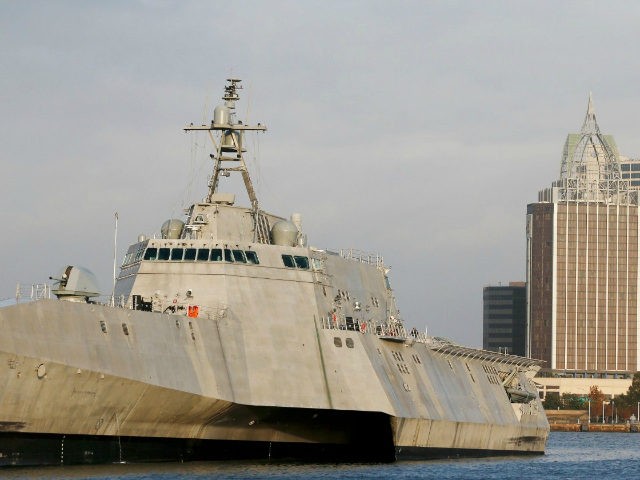The Navy took the last step before commissioning, when it took possession of USS Gabrielle Giffords, named for the former congresswoman, and the ninth hull of the $34 billion Littoral Combat Ship (LCS) program, a class of warships with so little firepower that to survive, they must outrun the enemy.
When Second Lady Jill Biden christened Giffords June 13, 2015, she said, “Wherever the USS Gabrielle Giffords travels—the world will know it is unrelenting, it is unstoppable, and it is the full definition of a patriotism that defines the greatest, most powerful country in the world.”
Unfortunately, for the 16th American warship named for a woman and the rest of the class, the LCS program is becoming a symbol of Pentagon mismanagement, along with the new $13 billion carrier USS Gerald R. Ford that some naval experts recommend scrapping rather than fixing and the troubled F-35 fighter jet.
Unlike many Coast Guard cutters, the LCS is meant to be deployed to trouble spots, like the four warships destined for Singapore in 2018. Another difference is that many cutters are armed with the MK-75 76mm deck guns with a maximum range of more than 20 miles; the deck guns fitted to the LCS have a maximum range of ten miles.
“The Navy’s own requirements show that the only — the only thing the Navy expects, if it’s hit by one of those kinds of threats, is for it to be able to exit the battle area and or provide for an orderly abandon ship,” said J. Michael Gilmore, the Pentagon’s director of Operational Test and Evaluation in sworn testimony December 1 in front of the Senate Armed Services Committee.
“A hit on one of these ships is going to be a real problem–if you can keep it out of harm’s way? OK,” he said.
Because of the ship’s speed and small size, it could avoid combat and find a place to hide from the hostilities, he said.
Gilmore told the committee, “In Total Ship Survivability trials that we did, the crews did their best, but in almost every incidence, there was major damage to the ship and the combat capability was fully lost, and in some instances the ship would have been lost.”
“These ships will still be faster than any other combatant or warship that we have today,” said Sean J. Stackley, the assistant secretary of the Navy for research, development and acquisition, who testified with Gilmore and Vice Adm. Thomas S. Rowden, the commander of the Pacific Fleet’s surface warfare assets.
In his opening remarks at the hearing, the committee chairman, Sen. John S. McCain III (R-Ariz.), referred to the LCS class as an “alleged warship.”
McCain said despite all of the signs of trouble, the Navy has rushed the littoral program into production and deployment so that of the 40 ships now planned, 65 percent of them are either delivered or under construction.
“For some reason, Navy leaders prioritized deploying a ship with no capability over completing necessary mission package testing,” he said. “In other words, the taxpayers have paid for—and are still paying for—26 ships that have demonstrated next-to-no combat capability,” he added. “This is unacceptable.”
Sen. Daniel S. Sullivan (R-Alaska), also at the hearing, asked Rowden, “Could an LCS in the fleet today survive attacks from small boats and other patrol crafts like the ones that were used in the recent capture of American sailors by Iran? Are you confident of that, given what Dr. Gilmore clearly states, it’s a ship that’s not combat survivable?”
Rowden: Yes, sir. I am.
Sullivan: Are you, Dr. Gilmore?
Gilmore: No.
Gilmore, who earned his PhD in nuclear engineering from the University of Wisconsin, said in the beginning, the ships were not meant for direct combat at all. Rather, they would be the platform for launching and retrieving lethal drones.
“The original vision for these ships was that they could use unmanned systems that would go in and conduct combat operations, and they could stand off away from threats,” he said. “But those unmanned systems that can reach out and conduct combat operations, we don’t have, and it isn’t clear when we ever will, so this ship was built to not be nearly as survivable, as for example the [previous small ships] that we used to have.”
The littoral program began in 2007 with the plan of 55 hulls at $220 million each. But, today the plan is for 40 hulls at $478 million each, according to the General Accounting Office’s December 8 report “Slowing Planned Frigate Acquisition Would Enable Better-Informed Decisions.” The GAO priced the ships, which the Navy now calls “frigates” using 2010 dollars. Frigates are traditionally heavily armed warships, but smaller than “ships of the line” or destroyers.
“Much of the LCS’s capabilities are yet to be demonstrated and the frigate’s design, cost, and capabilities are not well-defined,” according to the report, which also said that the Navy refused to show the GAO its damage assessments from rough sea trials and that the Navy has no plans to test how the ships would handle an underwater explosion. This was a reference to the Navy’s decision to abandon testing of the vessel’s mine countermeasure systems.

COMMENTS
Please let us know if you're having issues with commenting.